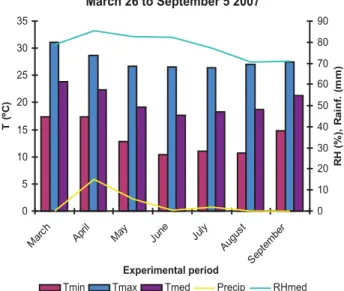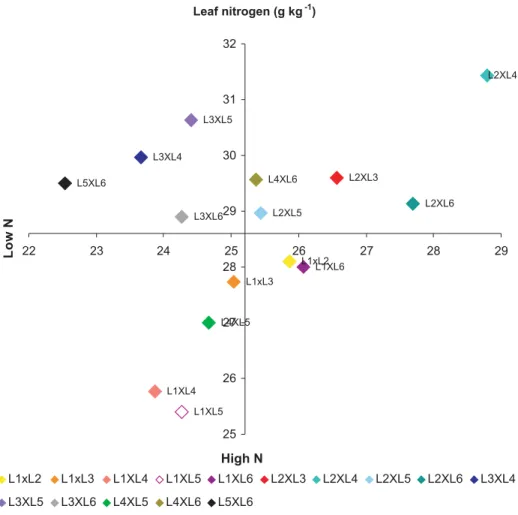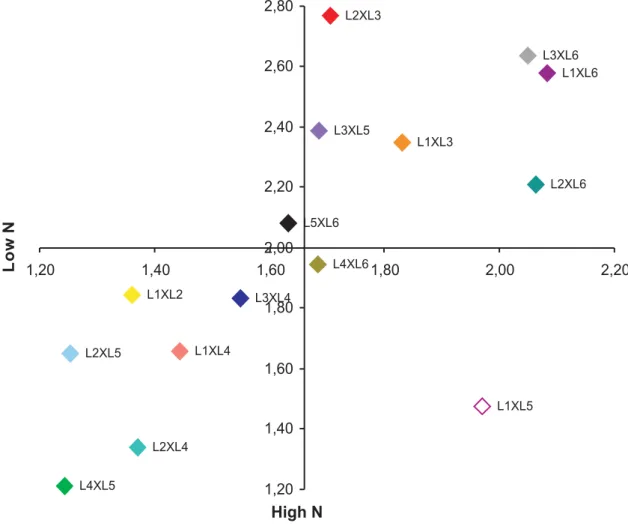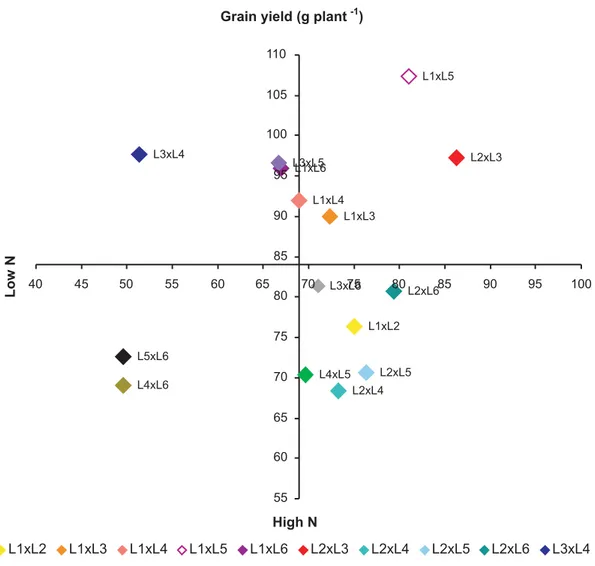Crop Breeding and Applied Biotechnology 8: 291-298, 2008 Brazilian Society of Plant Breeding. Printed in Brazil
Received 07 March 2008
Accepted 03 October
Nitrogen-use efficiency of maize genotypes in
contrasting environments
Amanda Oliveira Martins1, Eliemar Campostrini1, Paulo César Magalhães2, Lauro José Moreira Guimarães2, Frederico Ozanan Machado Durães3, Ivanildo Evódio Marriel2, and Alena Torres Netto1
ABSTRACT - The purpose of this study was to evaluate the nitrogen-use efficiency of 15 corn hybrids in different environments. The experiment was conducted at the research station Embrapa Milho e Sorgo, in environments with low (12 kg ha-1) and high
(120 kg ha-1) nitrogen fertilization, in a randomized block design with three replications. The chlorophyll content, leaf
nitrogen and nitrate reductase activity in the flag leaf were determined at flowering and the grain yield was evaluated at harvest. The chlorophyll content proved to be sensitive to nitrogen availability, although without discriminating genotypic differences efficiently. To use nitrate reductase for this purpose, further studies are needed on the reliability of this biochemical variable to diagnose genotypes efficient in N use precociously. The hybrid L2xL3 was considered promising for maize breeding programs aimed at gene introgression related to N-use efficiency.
Key words: Zea mays L., nitrogen, chlorophyll content, leaf nitrogen, yield.
1 Universidade Estadual do Norte Fluminense Darcy Ribeiro (UENF/CCTA /LMGV), Avenida Alberto Lamego, 2000, Horto, 28.015-620, Campos dos
Goytacazes, RJ, Brazil. * E-mail: aom@uenf.br
2 Centro Nacional de Pesquisa de Milho e Sorgo, Empresa Brasileira de Pesquisa Agropecuária, Rodovia MG 424, km 65, Zona Rural, 35.701-970, Sete
Lagoas, MG, Brazil
3 Parque Estação Biológica, Centro de Pesquisa, Empresa Brasileira de Pesquisa Agropecuária, Avenida W3 Norte (final), 70.770-901, Brasília, DF, Brazil INTRODUCTION
Nitrogen is the nutrient required in highest quantities by corn and is one of the essential constituents of enzymes, amino acids (proteins), nucleotides (nucleic acids), hormones and chlorophyll molecules, among other compounds of the plant metabolism (Malavolta et al. 1997, Cantarela and Duarte 2004, Taiz and Zeiger 2006). According to Malavolta et al. (1997) nitrogen deficiency symptoms first appear in the tips of older maize leaves, as yellowing in an inverted V shape. Deformation at the tip of the ear is observed in some cases. Under deficiency conditions, this
nutrient is the main limiting factor for plant growth and can significantly affect corn yields.
In Brazil, the low corn yield of about 3500 kg ha-1
In general, high nitrogen doses are used in comparative experiments of corn yields of cultivars. However, this practice leads to the indication of cultivars that are highly responsive, but not necessarily efficient in N use. The adoption of responsive and inefficient cultivars results in high expenses with chemical nitrogen fertilizers, if the yield potential of the genotypes is to be fully exploited. Therefore, in adverse nutritional conditions, genotypes should be efficient in the use of inputs, well-adapted and more productive (Ferreira et al. 2001, Lu et al. 2001, Araújo et al. 2004).
Embrapa Milho e Sorgo introduced several genotypes from the CIMMYT (International Center for Improvement of Maize and Wheat, based in Mexico) in Brazil. In a maize improvement program the maize population CMS 28 was derived from Amarilo Dentado. Several lines were developed from this population in conditions of low N availability in the soil and classified into groups of lines with N-use efficiency or inefficiency.
For this study, six lines in the S6 generation, the three
most efficient and three least efficient lines in N use,
were crossed in a diallel to obtain the 15 hybrids (F1).
This study aimed to investigate mechanisms related to N-use efficiency, based on variables such as chlorophyll and leaf nitrogen contents, nitrate reductase activity and maize yield under different conditions of N availability in the field.
MATERIAL AND METHODS
Fifteen experimental hybrids derived from crosses
between six maize lines in S6 were evaluated in terms of
N-use efficiency. The lines L1, L2 and L3 were
characterized as efficient and lines L4, L5 and L6 as
inefficient in N use. The evaluations were conducted in environments with different levels of nitrogen availability. In the trial with low N level (N1) only 12 kg
ha-1 was applied (at sowing only), and in the experiment
with high N availability (N2), 120 kg ha-1 was applied
(12 kg ha- 1 at sowing and topdressing in two
applications of 54 kg ha-1 N). The urea topdressing was
applied at the growth stage of 4-8 fully expanded leaves of the maize plants. Both environments were fertilized
with 300 kg ha-1 of the NPK fertilizer 04-30-16 at sowing,
as sources of N, P2O5 and K2O, respectively.
The experiment was conducted in a factorial design (15 hybrids x 2 N levels) in an area of Embrapa Milho e Sorgo, in the county of Sete Lagoas, Minas Gerais (lat 19 28' 00'’ S, long 44 ° 15' 08'’ W, 732 m asl).
According to Köppen the regional climate type is AW (savannah with dry winter). Maize was sown in the winter (March 26, 2007), and irrigation was applied when required.
The experiment had a randomized block design with three replications. Each plot consisted of a 5 m-long row, leaving five plants per meter after thinning, spaced 0.80 m between rows. The cultural treatments followed recommendations Embrapa Milho e Sorgo for production systems, according to crop requirements.
The soil, sampled at two depths (0 to 0.20 m), was analyzed at the laboratory of soil fertility of Embrapa Milho e Sorgo. The analysis indicated, respectively, in the environment of low and high N: water pH 5.40 and
5.30; 22.27 and 36.81 mg dm-3 P; 97 and 166 mg dm-3 K;
0.25 and 0 cmolc dm-3 Al3+; 3.09 and 4.15 cmolc dm-3
Ca2+; 0.63 and 0.81 cmol
c dm-3 Mg2+; 2.98 and 3.02 dag
kg-1 of organic matter.
The rainfall distribution profiles (Rainf, in mm), temperature (T, in ºC) and relative humidity (RH, in %) during the experiment are shown in Figure 1.
The chlorophyll content was estimated by the portable chlorophyll meter model SPAD-502 (Minolta, Japan) using the average of six readings per leaf for each genotype and three plants per plot during crop flowering. The measurements were performed in the flag leaf, selecting only the third middle of the blade, 2 cm away from the leaf edge, without the midrib of the mature leaf.
For the quantification of the enzyme activity of nitrate reductase (NR) at flowering, three plants per plot were sampled in three replications per environment (low and high N). The sampling was conducted between 9 and 10 AM, when the plants had already received at least three hours of sunlight and the NR activity had possibly reached its maximum (Lilo and Rooff 1989). For the biochemical analysis of the nitrogen metabolism enzyme the NR enzyme activity was quantified following
the in vivo methodology described by Hageman and
Reed (1980). The leaf samples were packed in ice-cooled styrofoam box to paralyze enzyme activity and moved quickly to the laboratory for analysis. The leaf discs were removed from the middle third of the flag leaf, excluding the midrib.
To quantify the NR enzyme activity 0.5 g leaf sample was incubated at 30 °C in water bath with agitation, in the dark. We used 20 ml reaction medium
consisting of 0.1 M K2HPO4 pH 7.5, 0.1 M of KNO3, 1%
propane and 0.05% neutronix. Samples were removed from 0.5 mL after 10 and 40 minutes, respectively; at this point, the reaction was paralyzed by the addition of 0.5 mL 1% sulfanilamide dissolved in 1.5 N HCl. The nitrite produced was determined by the addition of 0.02% N (1-naphthyl)-ethylenediamine dihydrochloride in spectrophotometer readings at 540 nm. The enzyme activity was determined based on the produced amount
of nitrite (NO2-), in comparison with a previously
established standard curve for that ion. The results of this variable were expressed in umol NO2- g-1 fm h-1.
The leaf nitrogen content was analyzed in the laboratory of Plant Mineral Nutrition, of the Universidade Estadual do Norte Fluminense Darcy Ribeiro (UENF) using sub-samples of the plant tissue mentioned above. These leaf sub-samples were placed in labeled paper bags marked and oven-dried at 65 ºC with forced air circulation for 72 hours. After drying,
the material was ground in a stainless steel mill Wiley (20 mesh sieve).
To determine the N level in each treatment, 100 mg ground dry leaf was weighed and transferred to a test
tube with 3 ml H2SO4 and placed in a digester block in a
ventilated flue for 4 hours. In this condition the temperature was gradually increased up to 350 ºC. After sulfuric digestion, the levels of organic N (N-org) were determined by Nessler’s reagent (Jackson 1965). The
results of this variable were expressed in g kg-1 dry
matter. Yield (PROD) was determined by weighing the grain of three healthy plants per plot, adjusted to 13%
moisture and expressed in g plant-1.
The treatment means were compared by analysis of variance with the results for each variable. Initially, the individual analyses of variance were performed for each environment, and subsequently the joint analysis
of the environments low (N1) and high N (N2). Means
were compared with each other by the Scott Knott (1974) test at 1 and 5% probability, using the software SISVAR.
RESULTS AND DISCUSSION
The levels of nitrogen fertilizer applied at planting and as topdressing were adequate to distinguish the environments for N availability, therefore, for all variables studied, the mean squares for effect of N rates in the analysis of variance was significant at 1% probability by the F test (Table 1).
Significant effects for genotypes were detected at 1 or 5% probability by the F test for most variables, indicating the presence of genetic variability. Meanwhile, values of the variable chlorophyll content were not significant at 5% probability, which indicates reduced genetic variability for this trait. This physiological variable is therefore not appropriate to discriminate differences between genotypes (Table 1).
Traits1 Mean squares CV%
Nitrogen (N) Genotype (G) NxG Error
CC 295.21** 17.23 17.23 11.04 8.32
LN 344.56** 11.03* 5.19 5.34 8.66
RN 2.55** 0.76** 0.19 0.19 24.20
PROD 5228.84** 542.38** 335.15* 181.3389 17.53
GL 1 14 14 56
1 CC: chlorophyll content; LN: leaf nitrogen; RN: nitrate reductase; PROD: yield
The effect of genotype-environment interaction did not prove significant (p> 0.05) for most traits evaluated, except for grain yield, indicating a similar response of all evaluated genotypes to the environments of low and high N availability (Table 1). A significant interaction was detected for grain yield only at 5% probability by the F test, among genotypes and nitrogen levels, demonstrating the different performance of the experimental hybrids grown at the two nitrogen levels. Under these conditions, Cruz et al. (2004) reported that the response of a particular hybrid in one environment is not necessarily the same in another.
The coefficients of variation (CVs) were, respectively, 8.32% for chlorophyll content, 8.66% for leaf nitrogen, 24.20% for nitrate reductase activity and 17.53% for yield (Table 1). According to Pimentel Gomes (1985), the coefficients of variation can be classified as low (<10%), medium (10-20%), high (20-30%) and very high (> 30%). However, during the experiment, this classification does not take the crop studied into account, and the trait evaluated nor the soil-climatic conditions. Scapim et al. (1995) therefore proposed a classification of the coefficients of variation for some specific traits considered important in breeding programs of this type. Considering the above classifications, it was found that the coefficients of variation of most variables are generally within the normal patterns of experimentation with maize, which may indicate good accuracy of the experimental data.
Machado et al. (1992) assessed the enzyme activity involved in the N metabolism of corn and found values of 98.75% of coefficient of variation for nitrate reductase. Majerowicz et al. (2002), studying the efficiency of nitrogen use in maize genotypes, evaluated the activity of this enzyme and found values of CV of 26.5%. Therefore, the values of coefficients of variation found here are consistent with those found in literature for common corn.
Based on our results, it was found that higher soil nitrogen resulted in higher nitrogen absorption of plants, influencing the physiological, biochemical and agronomic traits evaluated (Table 2). Maize response to nitrogen is also reported in the study of Lu et al. (2001), Ferreira et al. (2001), Majerowicz et al. (2002), Duet et al. (2008).
Quadrant diagrams were designed for the variables, similarly as proposed by Fox (1978). These diagrams show the responses of the 15 hybrids derived from crosses between maize with efficient and inefficient N use.
The upper quadrants of the diagram contained the responsive genotypes, i.e., genotypes with response to a higher N availability by an increase in the variable evaluated. The lower quadrants include the genotypes with lower response potential, even in the presence of high N levels, and were designated non-responsive. The genotypes with a better environmental performance at low N availability were classified as efficient, and those with below-mean performance at low N as inefficient in N use. For each evaluated variable, the overall mean of each N level (low and high N) was used to divide the diagram in quadrants. Hybrids with means below the overall mean at low and high N were classified as inefficient and non-responsive, respectively. On the other hand, hybrids with higher means at both N levels were classified as efficient and responsive, respectively. However, hybrids with higher means at only one N-availability level can be classified as non-responsive and efficient or inefficient and responsive.
Among the hybrids derived from crosses between
the N-use efficient lines, L2xL3 and L1xL3 for nitrate
reductase (Figure 3) and L2xL3 for leaf nitrogen (Figure
2) are represented in the upper right quadrant, and are
therefore considered efficient and responsive. L4xL5, a
hybrid of N-use inefficient lines, for the two variables in question, is represented in the lower left quadrant.
L1xL3 and L1xL2 hybrid combinations and are
represented in the lower left quadrant, for the variables, leaf nitrogen and nitrate reductase, respectively (Figures 2 and 3). These crosses differed from the expected response, since they are derived from N-use efficient lines. This suggests that the contribution of at least
one of the parents, possibly of line L1, confers no
contribution to a higher LN and NR in maize plants for these two traits.
Traits1 N1 N2
CC 38.10 a 41.70 b
LN (g kg-1) 24.70 a 28.60 b
RN (µmol NO2- g-1 fm h-1) 1.66 a 2.00 b
PROD (g plant-1) 69.20 a 84.40 b
Table 2. Means of the traits CC, LN, RN and PROD for the 15 diallel hybrids derived from crosses of six contrasting lines in N-use efficiency, in the environments low (N1) and high N availability (N2)
1 CC = chlorophyll content; LN = leaf nitrogen; RN = nitrate reductase and
PROD = yield
The overall means for NR activity at low and high
N levels were, respectively, 1.66 and 2.00 µmol NO2- g-1
fm h-1. These results are consistent with those of Purcino
et al. (1994) in the field, who found an enzyme activity between 1.68 to 2.46 and 1.61 to 2.18 µmol NO2- g-1 fm h
-1 in maize genotypes grown at two levels of nitrogen
fertilization (application of 20 kg ha-1 and 60 kg ha-1,
respectively).
By plotting the mean grain yield it was observed (Figure 4) that hybrids L1xL3, L1xL5 and L2xL3 appear in
the upper right quadrant and were therefore classified as efficient in N use and responsive to nitrogen fertilization. Hybrids L4xL6 and L5xL6 are scattered in
the lower left quadrant of this figure and were therefore classified as inefficient in N use and non-responsive to
nitrogen fertilization. In this group, only hybrid L4xL5
was considered efficient, although non-responsive. This corroborates similar results of Guimarães (2006)
who studied lines with contrasting N use and showed that for the trait grain yield the genotypes selected as efficient were superior to the inefficient. Besides, both in environments with low well as high N the hybrids derived from N-use efficient lines tended to be classified as efficient while those obtained from crosses between inefficient lines tended to be inefficient.
The study of Guimarães (2006) showed that for this set of lines, the N-use efficiency and response to the application of mineral nutrients are conditioned by genetic factors, which confer a predictable response pattern, allowing the choice of appropriate parents and a synthesis of superior hybrid from N-use efficient lines. Therefore, one can infer that among the hybrids
tested, the most promising is L2xL3, which can be
considered efficient in N use and responsive to nitrogen fertilization, with higher yields in both environments (Figure 4). Probably, this response is related to higher Figure 2. Response to nitrogen fertilization of 15 F1 hybrids derived from crosses of six contrasting lines of the maize population CMS
values found for leaf nitrogen content and NR activity (Figures 2 and 3, respectively) in both environments evaluated. This information indicates the need for further studies on the possibility of using the enzyme as tool underlying the development of more productive genotypes, due to the greater N-use efficiency.
Based on the results of this study, we could conclude that the chlorophyll content was sensitive to nitrogen availability, but could not be considered an effective trait to discriminate differences between genotypes.
The values of hybrid L2xL3 were high for the traits
NR and LN, and also showed high grain yield in environments with low and high nitrogen availability. Therefore, these traits may be related to mechanisms of N-use efficiency and response to the application of this nutrient.
Among the genotypes, the hybrid L2xL3 can be
considered promising for use in maize breeding programs aimed at the introgression of genes related to N-use efficiency in elite genotypes.
Avaliação de genótipos de milho quanto à eficiência no
uso do nitrogênio em ambientes contrastantes
RESUMO - O objetivo destetrabalho foi avaliar, em ambientes contrastantes, o desempenho de 15 híbridos de milho, quanto à eficiência no uso de nitrogênio. O experimento foi realizado na Embrapa Milho e Sorgo, em ambientes com baixa (12 kg ha-1) e alta (120 kg ha-1) adubação nitrogenada. Foi utilizado o delineamento em blocos casualizados,
ACKNOWLEDGEMENTS
We thank the UENF for the scholarship, particularly Professor Pedro Henrique Monnerat (Plant Mineral Nutrition Sector), the Coordenação de Aperfeiçoamento de
Pessoal de Nível Superior (CAPES) for research support, and the Centro Nacional de Pesquisa de Milho e Sorgo for the support with infrastructure for this study.
Figure 4. Response to nitrogen fertilization of 15 F1 hybrids derived from crosses of six contrasting lines of the maize population CMS
com três repetições. No florescimento foram feitas determinações do teor de clorofila, nitrogênio foliar e redutase do nitrato, utilizando a folha bandeira e na colheita foi determinada a produtividade de grãos. O teor de clorofila foi sensível à disponibilidade de nitrogênio, mas não foi considerado eficiente para discriminar diferenças genotípicas. A redutase do nitrato necessita de mais estudos, para considerá-la uma variável bioquímica confiável para diagnosticar precocemente genótipos eficientes no uso de nitrogênio. O híbrido L2xL3 pode ser considerado promissor para programas de melhoramento de milho visando introgressão de genes relacionados à eficiência na utilização do nitrogênio.
Palavras-chave: Zea mays L., adubação nitrogenada, teor de clorofila, nitrogênio foliar, produtividade.
REFERENCES
Araújo LAN, Ferreira ME and Cruz MCP (2004) Adubação nitrogenada na cultura do milho. Pesquisa Agropecuária Brasileira 39: 771-777.
Cantarela H and Duarte AP (2004) Manejo da fertilidade do solo para a cultura do milho. In: Galvão JCC and Miranda GV (eds.) Tecnologias de produção do milho. 20. Editora UFV, Viçosa, p. 139-182.
C r u z C D , R e g a z z i A J a n d C a r n e i r o P C S ( 2 0 0 4 ) Modelos biométricos aplicados ao melhoramento genético. 3th
ed., Universidade Federal de Viçosa, Viçosa, 480p.
Duet RRC, Muraoka T, Silva EC, Trivelin PCO and Ambrosano EJ (2008) Manejo da adubação nitrogenada e utilização do nitrogênio (15N) pelo milho em Latossolo Vermelho. Re-vista Brasileira de Ciência do Solo 32: 161-171. Fanceli AL and Dourado Neto D (2004) Produção de milho.
2nd ed, Guaíba Agropecuária, 360p.
Ferreira ACB, Araújo GAA, Pereira PRG and Cardoso AA (2001) Características agronômicas e nutricionais do milho adubado com nitrogênio, molibdênio e zinco. Scientia Agricola 58: 131-138.
Fox RH (1978) Selection for phosphorus efficiency in corn.
C o m m u n i c a t i o n s i n S o i l S c i e n c e a n d P l a n t A n a l y s i s 9: 13-37.
G u i m a r ã e s L J M ( 2 0 0 6 ) C a r a c t e r i z a ç ã o d e g e n ó t i p o s d e milho desenvolvidos sob estresse de nitrogênio e he-rança da eficiência de uso deste nutriente. Tese DS, Universidade Federal de Viçosa, Viçosa, 122p.
Hageman RH and Reed AJ (1980) Nitrate reductase from higher plants. Methods in Enzymology 69: 270-280.
Jackson ML (1965) Soil chemical analysis. Prentice Hall, New Jersey, 498p.
Lilo C and Rooff P (1989) An unusually rapid light induced nitrate reductase mRNA pulse and circadian oscillations.
Naturwissenschaften Brande 76: 526-528.
Lu C, Zhang J, Zhang Q, Li L and Kuang T (2001) Modification
of photosystem II photochemistry in nitrogen deficient maize and wheat plants. Journal Plant Phisiology 158: 423-1 4 3 0 .
Machado AT, Magalhães JR, Magnavaca A and Silva MR (1992) Determinação da atividade de enzimas envolvidas no meta-bolismo do nitrogênio em diferentes genótipos de milho.
Revista Brasileira de Fisiologia Vegetal 4: 45-47. Majerowicz N, Pereira JMS, Medici LO, Bison O, Pereira MB
and Júnior UMS (2002) Estudo da eficiência de uso do nitro-gênio em variedades locais e melhorados de milho. Revista Brasileira Botânica 25: 129-136.
Malavolta E, Vitti GC and Oliveira SA (1997) Avaliação do e s t a d o n u t r i c i o n a l d a s p l a n t a s : p r i n c í p i o s e a p l i c a -ções. 2nd ed., POTAFOS, Piracicaba, 390p.
Pimentel Gomes F (1985) Curso de estatística experimen-tal. Esalq, São Paulo, 467p.
Purcino AAC, Magnavaca R, Machado AT and Marriel IE (1994) Atividade da redutase do nitrato em genótipos antigos e modernos de milho, cultivados sob dois níveis de nitrogênio.
Revista Brasileira de Fisiologia Vegetal 6: 41-46. Scapim CA, Carvalho CGP and Cruz CD (1995) Uma
pro-posta de classificação dos coeficientes de variação para a c u l t u r a d o m i l h o . P e s q u i s a A g ro p e c u á r i a B r a s i l e i r a 3 0: 6 8 3 - 6 8 6 .
Taiz L and Zeiger E (2006) Plant Physiology. 4th ed., Sinauer




